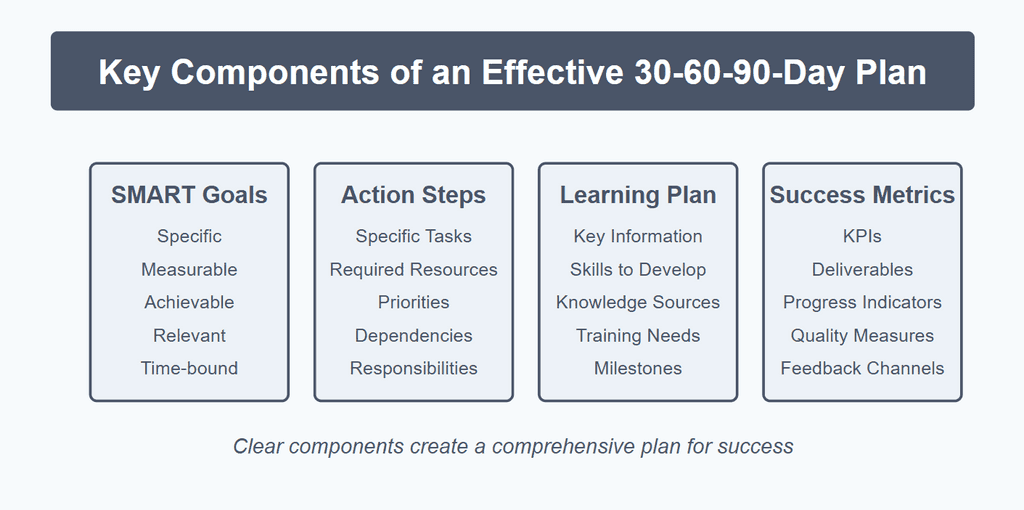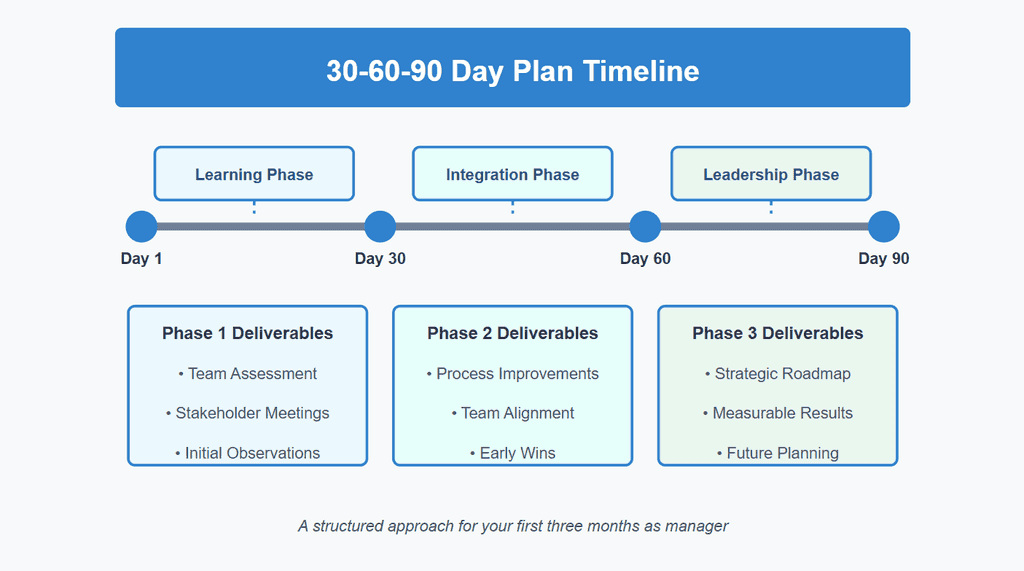Table of Contents
- Introduction
- What is a 30-60-90-Day Plan?
- The Benefits of Creating a 30-60-90-Day Plan
- Phase 1: The First 30 Days - Learning and Relationship Building
- Phase 2: Days 31-60 - Integration and Early Contributions
- Phase 3: Days 61-90 - Leadership and Strategic Implementation
- Key Components of an Effective 30-60-90-Day Plan
- Best Practices for Implementation
- Common Pitfalls to Avoid
- 5 Real-World Examples of Successful 30-60-90-Day Plans
- Conclusion
Introduction
Stepping into a new management role can be both exciting and overwhelming. The first three months are critical in establishing your leadership, understanding team dynamics, and setting the foundation for long-term success. This is where a 30-60-90-day plan for managers becomes an invaluable strategic tool.
Whether you're a first-time manager or transitioning to a new leadership position, having a structured roadmap for your first quarter can dramatically increase your chances of success. This comprehensive guide will walk you through creating and implementing an effective 30-60-90-day plan that will help you navigate your new role with confidence and clarity.
What is a 30-60-90-Day Plan?
A 30-60-90-day plan for managers is a strategic framework that outlines specific goals, actions, and deliverables for the first three months in a new management position. It divides this critical transition period into three distinct phases, each with unique objectives and focus areas.
This structured approach helps new managers:
- Set clear expectations with their team and leadership
- Prioritize tasks and responsibilities effectively
- Create measurable milestones for tracking progress
- Demonstrate strategic thinking and organizational skills
- Navigate the challenging transition period methodically
The beauty of a 30-60-90-day plan lies in its progressive nature—each phase builds upon the foundation established in the previous one, creating a natural evolution from learning to leadership.
The Benefits of Creating a 30-60-90-Day Plan
Implementing a well-crafted 30-60-90-day plan offers numerous advantages for new managers:
- Provides structure during uncertainty: Transitions can be chaotic, but a detailed plan creates clarity and direction.
- Increases confidence: Having a roadmap reduces anxiety and builds self-assurance in your approach.
- Demonstrates initiative: Shows your commitment to success and proactive leadership style.
- Sets realistic expectations: Helps align your goals with organizational timelines and capabilities.
- Facilitates communication: Serves as a tool for transparent discussions with your team and supervisors.
- Accelerates integration: Helps you become a productive team member faster by focusing on the right priorities.
- Creates accountability: Establishes clear metrics for measuring your progress and performance.
According to a study by Leadership IQ, managers who create structured onboarding plans are 69% more likely to feel successful in their new roles within the first 90 days compared to those who don't.
Phase 1: The First 30 Days - Learning and Relationship Building
The initial 30 days of your 30-60-90-day plan should focus primarily on absorbing information, establishing key relationships, and understanding the existing landscape. This is your learning phase.
Key Objectives:
-
Understand the organizational culture and dynamics
- Observe team interactions and communication patterns
- Learn about company values, mission, and goals
- Identify formal and informal power structures
-
Build relationships with stakeholders
- Schedule one-on-one meetings with each team member
- Connect with peers and cross-functional partners
- Establish rapport with your manager through regular check-ins
-
Assess current state of affairs
- Review team performance metrics and historical data
- Identify ongoing projects and their status
- Understand existing processes and workflows
-
Gather information about challenges and opportunities
- Listen to team members' perspectives on obstacles
- Identify immediate pain points that need addressing
- Look for quick wins that can build momentum
Example Activities:
- Create a stakeholder map identifying key relationships
- Review previous performance reports and team metrics
- Shadow team members to understand their daily work
- Ask open-ended questions about what's working and what's not
- Document observations about team dynamics and culture
Example: Sarah, a new marketing manager, spent her first 30 days conducting individual meetings with each team member, reviewing past campaign performance, and mapping out the current project landscape. By day 30, she had compiled a comprehensive assessment of her team's strengths, weaknesses, and immediate opportunities without making any significant changes.
Phase 2: Days 31-60 - Integration and Early Contributions
The second month of your 30-60-90-day plan transitions from passive learning to active participation. This phase focuses on applying what you've learned, making initial contributions, and beginning to implement changes.
Key Objectives:
-
Start implementing small improvements
- Address immediate pain points identified in the first phase
- Streamline existing processes where possible
- Introduce new tools or methods to enhance productivity
-
Develop and communicate your vision
- Begin articulating your leadership philosophy
- Share preliminary ideas for team direction
- Align your vision with organizational objectives
-
Deepen team relationships
- Provide initial feedback and coaching
- Identify development opportunities for team members
- Build trust through consistent communication
-
Take on more responsibility
- Lead team meetings and discussions
- Make decisions within your scope of authority
- Take ownership of specific projects or initiatives
Example Activities:
- Implement one process improvement based on first-month observations
- Develop preliminary performance expectations for the team
- Begin regular team meetings with a clear structure
- Create a feedback mechanism for team input
- Identify and execute on at least one "quick win" project
Example: Michael, a new IT manager, used his second month to implement a streamlined ticketing system that addressed the backlog issues he identified in month one. He also began weekly team stand-ups and created a skills matrix to better understand his team's capabilities and development needs.
Phase 3: Days 61-90 - Leadership and Strategic Implementation
The final month of your 30-60-90-day plan for managers is when you fully step into your leadership role. This phase focuses on strategic initiatives, measurable results, and setting a foundation for long-term success.
Key Objectives:
-
Implement strategic initiatives
- Launch significant projects or changes
- Address systemic issues identified in earlier phases
- Align team goals with broader organizational objectives
-
Demonstrate measurable impact
- Track and report on key performance indicators
- Document improvements and achievements
- Quantify your contributions where possible
-
Solidify your leadership approach
- Establish consistent management practices
- Create sustainable team processes and rhythms
- Reinforce cultural elements you want to emphasize
-
Plan for the future
- Set longer-term goals (6-12 months)
- Identify strategic opportunities for team growth
- Create development plans for team members
Example Activities:
- Develop a strategic plan for the next 6-12 months
- Implement a significant process improvement or new initiative
- Establish regular performance feedback mechanisms
- Present achievements and future plans to senior leadership
- Create a team development roadmap
Example: Elena, a new sales manager, used her third month to implement a comprehensive sales pipeline optimization strategy based on the data and team input gathered in months one and two. She established new sales targets, created a coaching program for underperforming representatives, and presented a six-month growth plan to the executive team.

Key Components of an Effective 30-60-90-Day Plan
A well-constructed 30-60-90-day plan should include these essential elements:
-
Clear, SMART goals for each phase
- Specific objectives that define success
- Measurable targets to track progress
- Achievable milestones that consider realistic timelines
- Relevant goals that align with organizational priorities
- Time-bound deliverables with specific deadlines
-
Detailed action steps
- Specific activities to accomplish each goal
- Resources needed for completion
- Dependencies or prerequisites
-
Learning objectives
- Key information you need to acquire
- Skills you need to develop
- Resources for gaining necessary knowledge
-
Relationship development strategies
- Key stakeholders to connect with
- Approaches for building trust and rapport
- Communication plans and cadences
-
Success metrics
- Clear indicators of progress
- Quantitative and qualitative measures
- Methods for tracking and reporting achievements
-
Potential challenges and mitigation strategies
- Anticipated obstacles
- Contingency plans
- Resources for overcoming challenges
Best Practices for Implementation
To maximize the effectiveness of your 30-60-90-day plan:
-
Keep it flexible
- Treat the plan as a living document
- Adjust timelines and goals as you learn more
- Be prepared to pivot based on new information
-
Seek regular feedback
- Schedule check-ins with your manager
- Ask team members for input
- Reflect on what's working and what's not
-
Balance quick wins with long-term thinking
- Identify opportunities for immediate impact
- Don't sacrifice strategic initiatives for short-term gains
- Build momentum through progressive achievements
-
Document your progress
- Keep track of accomplishments and learnings
- Note adjustments to the original plan
- Capture insights for future reference
-
Communicate proactively
- Share your plan with relevant stakeholders
- Provide regular updates on progress
- Be transparent about changes and challenges
-
Mind your pace
- Avoid trying to change too much too quickly
- Give yourself time to learn before making major decisions
- Balance action with reflection

Common Pitfalls to Avoid
Even with a well-structured 30-60-90-day plan, new managers can fall into these common traps:
-
Rushing to action
- Making significant changes before understanding the context
- Skipping the learning phase to appear productive
- Implementing solutions without identifying root problems
-
Setting unrealistic expectations
- Promising more than can be delivered in 90 days
- Underestimating the complexity of organizational challenges
- Failing to account for existing priorities and constraints
-
Neglecting relationship building
- Focusing too heavily on tasks and not enough on people
- Failing to establish trust before implementing changes
- Not investing time in understanding team dynamics
-
Trying to fix everything at once
- Spreading efforts too thin across multiple initiatives
- Lacking clear priorities for maximum impact
- Creating change fatigue among team members
-
Not adapting the plan
- Sticking rigidly to initial goals despite new information
- Failing to incorporate feedback and learnings
- Missing opportunities due to inflexibility
5 Real-World Examples of Successful 30-60-90-Day Plans
Example 1: Technology Department Manager
30 Days:
- Conducted technical skills assessment of all team members
- Audited existing systems and identified three critical vulnerabilities
- Created knowledge transfer sessions with outgoing manager
- Established weekly one-on-one meetings with each team member
60 Days:
- Implemented security patches for identified vulnerabilities
- Reorganized project assignments based on skills assessment
- Created standardized documentation procedures
- Established cross-training program for critical systems
90 Days:
- Developed technology roadmap aligned with business objectives
- Implemented new project management methodology
- Presented infrastructure upgrade proposal to executive team
- Established performance metrics dashboard for team visibility
Example 2: Human Resources Manager
30 Days:
- Reviewed all open positions and recruitment processes
- Audited employee engagement and turnover data
- Met individually with department heads to understand needs
- Assessed current onboarding and training programs
60 Days:
- Streamlined recruitment workflow reducing time-to-hire by 15%
- Implemented weekly recruitment status reports for department heads
- Redesigned new employee orientation program
- Began monthly HR office hours for employee questions
90 Days:
- Launched employee recognition program
- Developed strategic workforce planning model
- Created quarterly training calendar aligned with skill gaps
- Established HR metrics dashboard for executive team
Example 3: Marketing Team Manager
30 Days:
- Audited all marketing channels and campaign performance
- Reviewed customer personas and market positioning
- Assessed team skills and campaign execution capabilities
- Met with sales team to understand lead quality issues
60 Days:
- Restructured marketing calendar for better cross-channel coordination
- Implemented A/B testing framework for campaign optimization
- Created standardized campaign brief templates
- Developed integrated reporting system for marketing KPIs
90 Days:
- Launched new lead scoring system with sales team
- Presented comprehensive marketing strategy for next fiscal year
- Implemented content governance and brand consistency guidelines
- Established marketing attribution model for ROI tracking
Example 4: Operations Manager
30 Days:
- Conducted process mapping for all core operations
- Analyzed production metrics and identified bottlenecks
- Met with suppliers to review agreements and performance
- Assessed inventory management practices and issues
60 Days:
- Implemented daily stand-up meetings to address workflow issues
- Created standard operating procedures for top five critical processes
- Established performance dashboards for team visibility
- Reorganized workspace for improved efficiency
90 Days:
- Launched continuous improvement program with team leads
- Implemented new inventory management system
- Renegotiated terms with two key suppliers
- Developed operations strategy aligned with growth targets
Example 5: Sales Manager
30 Days:
- Analyzed sales data and pipeline by representative
- Reviewed customer accounts and segmentation strategy
- Observed sales calls and meetings to assess skills
- Audited CRM usage and data quality
60 Days:
- Implemented weekly sales pipeline reviews
- Created account planning templates for major clients
- Established consistent sales methodology across team
- Developed sales enablement resources for common objections
90 Days:
- Launched new territory alignment based on opportunity analysis
- Implemented tiered coaching program for performance improvement
- Created quarterly business review process for key accounts
- Presented sales forecast and strategy for upcoming year
Conclusion
A well-executed 30-60-90-day plan for managers is more than just a checklist—it's a strategic roadmap that transforms the challenging transition period into an opportunity for meaningful impact and leadership establishment. By following the structured approach outlined in this guide, you'll be able to navigate your new managerial role with confidence, clarity, and purpose.
Remember that while the plan provides structure, the most successful managers remain flexible and responsive to their specific organizational context. Use this framework as a foundation, but don't hesitate to adapt it to your unique situation and challenges.
Whether you're stepping into your first management role or taking on a new leadership challenge, a thoughtful 30-60-90-day plan demonstrates your commitment to success and provides a clear path forward during this critical transition period.
Are you a new manager creating your 30-60-90-day plan? Which phase do you think will be most challenging for your specific situation? Share your thoughts in the comments below!
